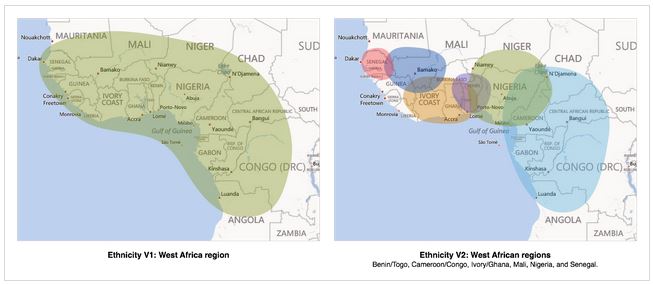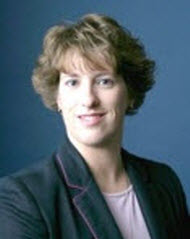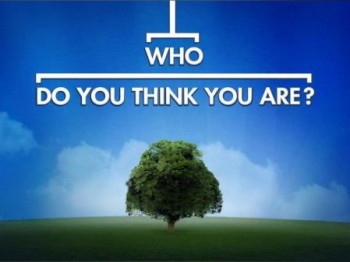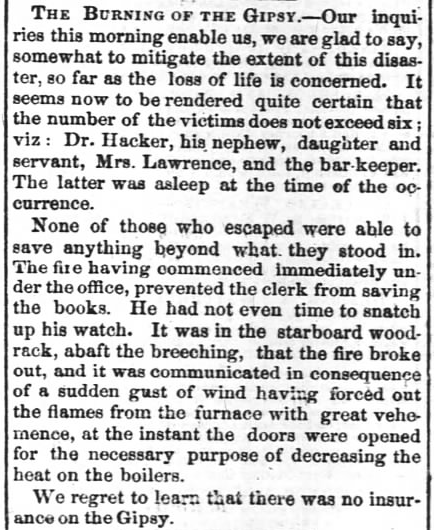by Lisa Cooke | Sep 19, 2013 | 01 What's New, African-American, Ancestry, DNA, Immigration
AncestryDNA announced last week that it has been able to identify six unique historic populations in West Africa. It’s a breakthrough they call a “finer-resolution genetic ethnicity estimate for individuals with West African ancestry.” They have even used this technology to start connecting the dots between those groups and millions of African-Americans whose ancestral paper trail was annihilated during the era of slavery.

For this latter development, the AncestryDNA team uses the “cluster genealogy” approach: the concept that people from the same location often migrated to the same areas. Of course, slavery forced apart families and other natural migration groups, both in Africa before the crossing and in the U.S. or other destinations. And the few records that remain of many of these folks and their enslaved descendants don’t include full names, place of origin or other data we rely on to make family connections. (Learn more about how to research African-American roots in Genealogy Gems Podcast Episode 159 with Dr. Deborah Abbott.)
It’s encouraging to read that AncestryDNA has had some success hooking up regional groups of African-Americans with specific areas of Africa. “Though this project is still in its infancy, the science team has made some progress,” AncestryDNA reports. “First, we looked at the birth locations of individuals in the trees of all African Americans. Then, we looked for locations where, relative to all African Americans, there appeared to be an over-representation of birth locations in trees of individuals with a particular West African ancestry. For individuals with Senegalese genetic ethnicity, we found what seems to be an over-representation of birth locations in South Carolina and Georgia in the 1700’s and 1800’s.”
by Lisa Cooke | Sep 18, 2013 | 01 What's New, British, Census, FamilySearch, Immigration, Military, Records & databases
It’s hard to keep up with the content constantly being added online at FamilySearch! If you (like me) spent the past month squeezing the last bit of travel an d sun from the summer, you may have missed some great new content. Here’s a recap:
d sun from the summer, you may have missed some great new content. Here’s a recap:
This month, over a half million indexed records and images have already shown up from Czech Republic, Hungary, Poland, Guatemala, Italy, New Zealand and the United States. Highlights include updates to the United States Social Security Death Index, images from the Czech Republic, Censuses, 1843–1921, collection, indexed records from the Hungary, Civil Registration, 1895–1980, collection, images from the new U.S., Indiana, Naturalization Records and Indexes, 1848-1992, collection and the Italy, Mantova, Mantova, Censuses (Comune), 1750-1900, collection, and indexed records from the U.S., Maine, State Archive Collections, 1718-1957, collection.
In August, FamilySearch.org added more than 45 million indexed records and images from BillionGraves and from Italy, the U.S., England, New Zealand, Sweden, Italy, Jamaica, Chile, Honduras and more. Notable U.S. additions are updates to the New Orleans Passenger Lists and newly-indexed war collections, including: the United States, World War II Prisoners of War of the Japanese, 1941-1945, collection, the United States, Korean War Battle Deaths, 1950-1957, collection, and the United States, Casualties of the Vietnam War, 1956-1998, collection.
A few more cool additions include:
- More than a half million images to a growing collection of Italy’s Civil Registrations;
- Nearly a million indexed Jamaican and a quarter million Chilean civil registrations;
- More than 2.5 million indexed recods from New Zealand passenger lists (1855-1973);
- Nearly a half-million indexed names from Boston passenger lists (1820-1891);
- Over 41 million indexed names added to the U.S. Public Record Index.
Search these and 3.5 billion more records at FamilySearch.org. Records are always free to search here, thanks both to the organization itself and thousands of volunteers around the world who index records. Join the effort here!
by Lisa Cooke | Sep 17, 2013 | 01 What's New, Family History Library, FamilySearch
 The biggest family history library in the world just got a new boss! Diane Loosle is the new Director of the flagship Family History Library (FHL) in Salt Lake City, Utah, and the first woman to hold this job. She has exciting ambitions for the FHL and I look forward to seeing how they unfold.
The biggest family history library in the world just got a new boss! Diane Loosle is the new Director of the flagship Family History Library (FHL) in Salt Lake City, Utah, and the first woman to hold this job. She has exciting ambitions for the FHL and I look forward to seeing how they unfold.
Diane mentions three specific goals she’ll focus on between now and the end of 2014:
- “Become more family and youth-oriented through providing interactive, discovery experiences.
- Enhance the services of the library through new collaborative research areas and better access to research staff.
- Engage more patrons from the geographic community surrounding the library.”
As an example of the first objective, a FamilySearch press release says Loosle wants to “study the role of the Family History Library and 4,700 satellite branches worldwide…and how to make them discovery centers for people of all ages, not just a research facility.”
“Our centers are great places to do genealogical research,” Loosle says. “[But] we need to figure out how to balance the needs of researchers while increasing appeal to those with other family history interests. You can’t attract a younger audience and offer the same experiences. We need to offer fun experiences and activities for the entire family that will increase love, appreciation, and understanding of their ancestors.”
I admit I’ve wondered about the future of satellite family history centers as increasingly folks stay home to research online. So I look forward to seeing how she will reinvent these community resources to serve today’s (and tomorrow’s) genealogical researchers.
Loosle comes to this job with great credentials. She is an accredited genealogist who has been with FamilySearch for 19 years, where she championed new customer service initiatives. She also has an MBA, strong business and leadership skills. She is described by a senior executive at FamilySearch as “one of the most qualified and capable to ever serve in this position.”
Congratulations, Diane! We look forward to seeing what’s coming next.
by Lisa Cooke | Sep 16, 2013 | 01 What's New, Ancestry, Who Do You Think You Are?
 The final episode of TLC’s first season of Who Do You Think You Are? came with more than just an extra helping of ancestral drama. Along with the end of the season came the welcome announcement that WDYTYA? will return in 2014 on TLC.
The final episode of TLC’s first season of Who Do You Think You Are? came with more than just an extra helping of ancestral drama. Along with the end of the season came the welcome announcement that WDYTYA? will return in 2014 on TLC.
First, the final episode recap: American actor Jim Parsons explored his paternal line and discovered one ancestor who was lost in a tragic accident–and another who narrowly escaped death by guillotine.
The Ancestry.com research team reports, “When we went digging into Jim Parsons’ family tree we found his third-great-grandfather was Jean Baptiste Hacker, a phy sician who was raised in New Orleans but moved to Plaquemine, Louisiana, after starting his medical career. Just a few years later, Dr. Hacker, along with his daughter Leocadie and his nephew, was killed in a tragic fire on board the steamboat Gipsy in December 1854.”
sician who was raised in New Orleans but moved to Plaquemine, Louisiana, after starting his medical career. Just a few years later, Dr. Hacker, along with his daughter Leocadie and his nephew, was killed in a tragic fire on board the steamboat Gipsy in December 1854.”
They documented the accident through an article from New Orleans paper the Daily Picayune (digitized at Newspapers.com and shown here):
Another line of research takes Jim’s ancestry back to France, where he learned one of his forebears was an architect to Louis XV. “The timing of Louis Francois [Trouard]’s appointment is significant: 1787 is only two years prior to the French Revolution. Four architects were executed during the Revolution, and another 25 were imprisoned. Yet Louis Francois escaped Republican retribution….”
“At the Chapelle de la Providence, a structure designed by his ancestor, Jim discovers the startling truth: Louis Francois had good revolutionary credentials, including houseguests such as Benjamin Franklin and John Adams.”
Along with that riveting last episode, TLC just announced it will bring back more of the same next season. On September 10, Digital Spy reported that 2014 will see 10 more episodes. Celebrity guests haven’t been announced yet, so stay tuned! We’ll keep you posted on future developments.
Meanwhile, TV watchers, mark your calendars for the American version of Genealogy Roadshow, the PBS show scheduled to debut next week.
by Lisa Cooke | Sep 16, 2013 | 01 What's New, Organization, Photographs
 In celebration of National Preparedness Month in the United States, I’m running a four-part post on securing your family history archive and research against disasters. Last week I talked about assessing and prioritizing your original family artifacts, photographs and documents. This week’s tip:
In celebration of National Preparedness Month in the United States, I’m running a four-part post on securing your family history archive and research against disasters. Last week I talked about assessing and prioritizing your original family artifacts, photographs and documents. This week’s tip:
DUPLICATE THE PAST. There’s no true substitute for an original family Bible, but if it’s lost, you at least want to have a copy. Scan your original photos, documents, and other flat artifacts—including the important pages of that Bible. While you could carefully use a flatbed scanner, consider a portable scanner or a mobile scanning app like Genius Scan or Scanner Pro.
Next, photograph dimensional family artifacts like artwork, handicrafts, clothing, military and school memorabilia, etc. Use a regular digital camera or the camera on your phone or tablet/iPad. Make sure you label the photos by using the metadata fields in digital files or by printing them out and captioning them in an album. Consider using the Heirloom Inventory Kit developed by the folks at Family Tree Magazine to create an archival record of your artifacts with images, stories and more.
Next week, we’ll tackle a third topic: preserving original documents, photos and heirlooms.


 d sun from the summer, you may have missed some great new content. Here’s a recap:
d sun from the summer, you may have missed some great new content. Here’s a recap:






